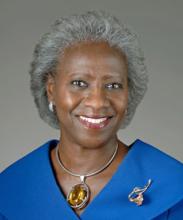
November, 2018
DR. VALANTINE'S FOOD FOR THOUGHT

Hannah A. Valantine, MD
Chief Officer for Scientific Workforce Diversity
There are so many ways diversity can enrich science. In this issue, read about one champion who uses creative outlets to showcase how disability fosters unique problem-solving abilities. Also check out a clever strategy to support early-career researchers as well as potential plans to include sex and gender minority data in national surveys of the U.S. biomedical doctorate population.
With Disability Comes Creativity
In recognition of October as National Disability Employment Awareness Month, NIH hosted nationally acclaimed author and filmmaker Crystal Emery, who suffers from physical disabilities due to muscular dystrophy. In her words, "A disability is neither a weakness nor a barrier to leading a successful personal and professional life. The real barrier is perception and unconscious bias." Emery founded URU The Right To Be, which brings awareness to societal gaps involving equity, diversity and inclusion.
What Are You Waiting For?
That’s a question visited by a now-retired MIT professor, who stepped out of the tenure pool to create more space for early-career investigators. Read about how some institutions are considering “professor, post-tenure” (not emeritus) flexible positions that enable senior researchers to continue to teach and supervise students, and to be a principal investigator on research grants.
A Step Toward Tracking Diverse Forms of Diversity
Each year, thousands of new biomedical Ph.D.s answer a barrage of questions about their age, sex, race, ethnicity, and career plans - as part of the National Science Foundation’s (NSF’s) Survey of Earned Doctorates. The long-time questionnaire has served as an annual census of U.S. doctoral degree-grantees since 1957 and is used to track diversity efforts. In an effort to capture more forms of diversity, NSF is considering the feasibility of adding questions about sexual orientation and gender identity.
Harassment Doesn't Work Here
On October 22, 2018, NIH rolled out a comprehensive effort to define and address workplace harassment in all its forms, in response to findings and recommendations of a landmark National Academies of Sciences, Engineering and Medicine report on sexual harassment of women in science. Among the report’s key findings: gender harassment - a range of behaviors verbal and non-verbal that convey insulting, hostile, and degrading attitudes about one’s gender - is by far the most common type of sexual harassment. In January 2019, NIH will administer an all-personnel survey to measure workplace climate: a key first step toward preventing all forms of sexual harassment.

The links above are pulled from the top news articles trending on the subject of diversity in science and technology.
The stories selected are not a reflection of the views of the National Institutes of Health.

